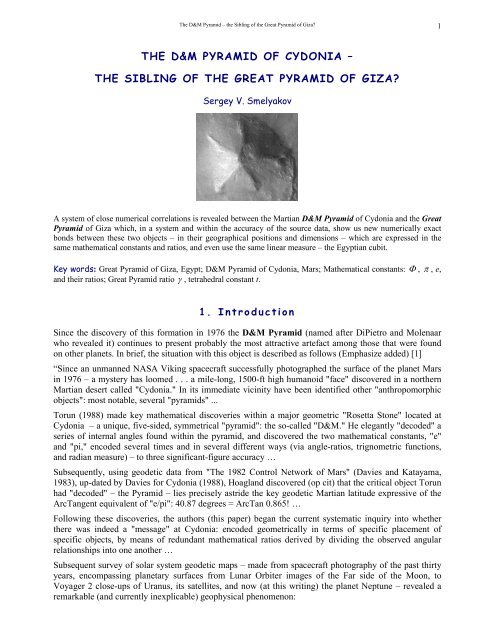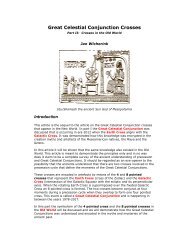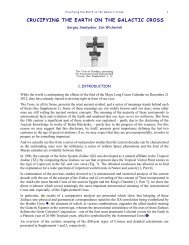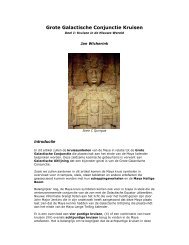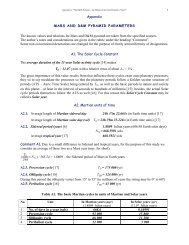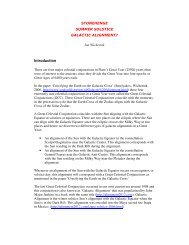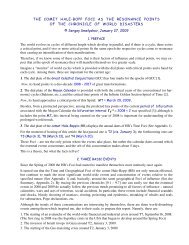THE D&M PYRAMID OF CYDONIA â THE ... - Souls of Distortion
THE D&M PYRAMID OF CYDONIA â THE ... - Souls of Distortion
THE D&M PYRAMID OF CYDONIA â THE ... - Souls of Distortion
Create successful ePaper yourself
Turn your PDF publications into a flip-book with our unique Google optimized e-Paper software.
The D&M Pyramid – the Sibling <strong>of</strong> the Great Pyramid <strong>of</strong> Giza? 1<br />
<strong>THE</strong> D&M <strong>PYRAMID</strong> <strong>OF</strong> <strong>CYDONIA</strong> –<br />
<strong>THE</strong> SIBLING <strong>OF</strong> <strong>THE</strong> GREAT <strong>PYRAMID</strong> <strong>OF</strong> GIZA?<br />
Sergey V. Smelyakov<br />
A system <strong>of</strong> close numerical correlations is revealed between the Martian D&M Pyramid <strong>of</strong> Cydonia and the Great<br />
Pyramid <strong>of</strong> Giza which, in a system and within the accuracy <strong>of</strong> the source data, show us new numerically exact<br />
bonds between these two objects – in their geographical positions and dimensions – which are expressed in the<br />
same mathematical constants and ratios, and even use the same linear measure – the Egyptian cubit.<br />
Key words: Great Pyramid <strong>of</strong> Giza, Egypt; D&M Pyramid <strong>of</strong> Cydonia, Mars; Mathematical constants: Φ , π , e,<br />
and their ratios; Great Pyramid ratio γ , tetrahedral constant t.<br />
1 . I n t r o d u c t i o n<br />
Since the discovery <strong>of</strong> this formation in 1976 the D&M Pyramid (named after DiPietro and Molenaar<br />
who revealed it) continues to present probably the most attractive artefact among those that were found<br />
on other planets. In brief, the situation with this object is described as follows (Emphasize added) [1]<br />
“Since an unmanned NASA Viking spacecraft successfully photographed the surface <strong>of</strong> the planet Mars<br />
in 1976 – a mystery has loomed . . . a mile-long, 1500-ft high humanoid "face" discovered in a northern<br />
Martian desert called "Cydonia." In its immediate vicinity have been identified other "anthropomorphic<br />
objects": most notable, several "pyramids" ...<br />
Torun (1988) made key mathematical discoveries within a major geometric "Rosetta Stone" located at<br />
Cydonia – a unique, five-sided, symmetrical "pyramid": the so-called "D&M." He elegantly "decoded" a<br />
series <strong>of</strong> internal angles found within the pyramid, and discovered the two mathematical constants, "e"<br />
and "pi," encoded several times and in several different ways (via angle-ratios, trignometric functions,<br />
and radian measure) – to three significant-figure accuracy …<br />
Subsequently, using geodetic data from "The 1982 Control Network <strong>of</strong> Mars" (Davies and Katayama,<br />
1983), up-dated by Davies for Cydonia (1988), Hoagland discovered (op cit) that the critical object Torun<br />
had "decoded" – the Pyramid – lies precisely astride the key geodetic Martian latitude expressive <strong>of</strong> the<br />
ArcTangent equivalent <strong>of</strong> "e/pi": 40.87 degrees = ArcTan 0.865! …<br />
Following these discoveries, the authors (this paper) began the current systematic inquiry into whether<br />
there was indeed a "message" at Cydonia: encoded geometrically in terms <strong>of</strong> specific placement <strong>of</strong><br />
specific objects, by means <strong>of</strong> redundant mathematical ratios derived by dividing the observed angular<br />
relationships into one another …<br />
Subsequent survey <strong>of</strong> solar system geodetic maps – made from spacecraft photography <strong>of</strong> the past thirty<br />
years, encompassing planetary surfaces from Lunar Orbiter images <strong>of</strong> the Far side <strong>of</strong> the Moon, to<br />
Voyager 2 close-ups <strong>of</strong> Uranus, its satellites, and now (at this writing) the planet Neptune – revealed a<br />
remarkable (and currently inexplicable) geophysical phenomenon:
The D&M Pyramid – the Sibling <strong>of</strong> the Great Pyramid <strong>of</strong> Giza? 2<br />
The majority <strong>of</strong> "active centres" on these objects – from the greatest shield volcanos on the "terrestrial<br />
planets" (including equivalent features on their most anomalously active satellites!), to the enormous<br />
atmospheric disturbances seen on some "gas giants" ("The Great Red Spots" <strong>of</strong> Jupiter and, now, <strong>of</strong><br />
Neptune) seem preferentially to occur very close to 19.5 degrees N. or S., irrespective <strong>of</strong> other planetary<br />
factors – mass, rotation rate, obliquity to their respective orbits, etc. … {SS: to this end, See [2]}”<br />
Geomorphological and geometrical analysis <strong>of</strong> the D&M Pyramid [3] shows (Emphasize added):<br />
“This investigation <strong>of</strong> the D&M Pyramid reveals a morphology that is inconsistent with the surrounding<br />
geology. The geomorphological processes observed to exist on Mars not only fail to provide a potential<br />
mechanism for the D&M Pyramid's formation, but seem to preclude its very existence. Analysis <strong>of</strong> the<br />
object's geometry, and its alignment with other anomalous landforms, reveal intricate relationships that<br />
are numerous and logical, and are suggestive <strong>of</strong> highly sophisticated design. …<br />
The same techniques used for most <strong>of</strong> this century in air photo interpretation show that the D&M Pyramid<br />
may be artificial, or may be a natural landform modified by intelligence. The true nature <strong>of</strong> this object<br />
can be resolved by re-imaging the Cydonia region to obtain high-resolution imagery <strong>of</strong> the D&M<br />
Pyramid and the other enigmatic landforms nearby. The issue <strong>of</strong> possible ruins at Cydonia is thus the only<br />
question involving extraterrestrial intelligence that can be easily resolved with known scientific means.”<br />
All these “non-random” characteristics <strong>of</strong> the D&M Pyramid provoke us to continue analysis <strong>of</strong> its<br />
geometrical and geographical properties; this automatically presumes advancing a hypothesis that the<br />
D&M Pyramid is an artificial structure, or rather a natural landform modified by intelligence, since<br />
otherwise a reconstruction the D&M’s design makes no sense. The latter formulation is probably more<br />
accurate due to a huge size <strong>of</strong> the D&M and observed irregularities in its design; the more so since the<br />
faces show greater liability to erosion than the edges: this may mean that the edges were somehow<br />
reinforced.<br />
In both <strong>of</strong> these cases there exists no other alternative than to imply that the D&M’s design had followed<br />
some plan. If so, it is naturally to suggest that – as in the case with the Great Pyramid <strong>of</strong> Giza (GP) – the<br />
Martian geographical mile and basic side (when taken for the intrinsic units <strong>of</strong> length) specify – in a<br />
system <strong>of</strong> absolute values and dimensionless ratios – other exterior parameters <strong>of</strong> both this object and<br />
Mars itself, or take the values <strong>of</strong> primal unit <strong>of</strong> angular measure, or most important mathematical<br />
constants associated with the regular triangles corresponding to the D&M’s floor plan elements.<br />
In case <strong>of</strong> the Great Pyramid <strong>of</strong> Giza a series <strong>of</strong> Earth and Space parameters, as well as the most<br />
important mathematical constants are expressed with the use <strong>of</strong> integers presenting its horizontal and<br />
vertical dimensions in inches and cubits. However, only an approximate floor plan <strong>of</strong> the heavily eroded<br />
D&M Pyramid is at our disposal, and without a small enough unit <strong>of</strong> length. For these reasons in analysis<br />
<strong>of</strong> the exterior <strong>of</strong> the D&M Pyramid we use the following approach.<br />
1. Firstly, for the primal unit <strong>of</strong> length being intrinsic to the D&M the length <strong>of</strong> the shortest side <strong>of</strong> this<br />
pyramid is taken, a = 1. Then, with the use <strong>of</strong> trigonometry and Torun’s angles [3], the lengths <strong>of</strong> other<br />
quantities: sides, perimeter and area <strong>of</strong> the D&M are obtained. This approach allows us to parameterize<br />
the geometry <strong>of</strong> the D&M so that:<br />
- with this intrinsic unit <strong>of</strong> length both the ratios and absolute values <strong>of</strong> parameters are meaningful;<br />
- for any other unit <strong>of</strong> length we firstly obtain the length a; then, the value p <strong>of</strong> any linear (or areal)<br />
2<br />
parameter obtained for the case a=1 takes the value p× a ( p × a , respectively).<br />
In parallel with these calculated values, we consider approximants for the edges presenting the primal<br />
D&M elements which are used for evaluating the derived quantities in the same manner. These are the<br />
numbers pertaining to the regular triangle (<br />
3<br />
2<br />
and e π<br />
), pentagon (Golden section Φ ), and 45° right<br />
triangle ( 2 ).<br />
Then, if both approaches give the results which coincide within the source data error we may conclude<br />
that the primal and derived approximants are consistent and thus present the intrinsic feature <strong>of</strong> the D&M.
The D&M Pyramid – the Sibling <strong>of</strong> the Great Pyramid <strong>of</strong> Giza? 3<br />
2. After then, for the unit <strong>of</strong> length being intrinsic for Mars a Martian geographical mile is taken. In this<br />
case, as with the Great Pyramid, both the ratios and absolute values <strong>of</strong> parameters are also meaningful.<br />
2 . D & M F l o o r P l a n G e o m e t r y . B a s i c M o d e l<br />
2.1. Linear parameters <strong>of</strong> the pyramid<br />
Consider the Basic model <strong>of</strong> the D&M pyramid – the Torun’s floor plan [3, A5.1], which is presented by<br />
the pentagon P = ABCDE (Fig. 1). As far as in the below analysis we consider both this pentagon and its<br />
fragmentation into the presented triangles, all segments shown in Fig. 1 are called sides.<br />
A<br />
H<br />
a<br />
α<br />
α<br />
T 1<br />
T′ 1<br />
a<br />
B<br />
α<br />
a<br />
α<br />
E<br />
γ<br />
a<br />
a<br />
α<br />
α<br />
G<br />
T 2<br />
β<br />
η<br />
η<br />
O<br />
T′<br />
2<br />
b<br />
b<br />
c<br />
T 3<br />
c<br />
ε<br />
ς<br />
d<br />
ς<br />
C<br />
α = 60. 0° β = 85. 3°<br />
γ = 49. 6°<br />
ε = 45. 1° η = 34.7`°<br />
ζ = 55. 3°<br />
F<br />
Fig. 1. Basic Model <strong>of</strong> the D&M Pyramid [3]<br />
D<br />
Since the absolute error in the angles specified in [3] makes ± 0 . 2°<br />
, the relative error <strong>of</strong> the source data<br />
does not exceed<br />
0.2°<br />
δ = ≈ 0.6%<br />
(1)<br />
34.7°<br />
Within this model the pentagon P is symmetric along the axis AO where O is the projection <strong>of</strong> the<br />
pyramid apex. As a consequence, this means the pairwise equality <strong>of</strong> the following triangles
The D&M Pyramid – the Sibling <strong>of</strong> the Great Pyramid <strong>of</strong> Giza? 4<br />
T 1 = AOB and T′ 1 = OAE ; (2)<br />
T 2 = OBC and T′<br />
2 = OED . (3)<br />
The given angles uniquely define the form <strong>of</strong> the pentagon P; their properties were studied in [3].<br />
However, its size remains indefinite until we fix up the length <strong>of</strong> one <strong>of</strong> its sides. Therefore, with the aim<br />
to investigate the linear properties <strong>of</strong> this object we have to define the length <strong>of</strong> its elements. For this,<br />
evaluate the lengths <strong>of</strong> its linear elements and areas as the functions <strong>of</strong> its shortest side AO, the length <strong>of</strong><br />
which denote by a. Note, that this side also defines the axis <strong>of</strong> symmetry for the pentagon P and rhombus<br />
OBAE; besides, the value a is repeated five times among the considered sides.<br />
Then, in compliance with the law <strong>of</strong> sines the lengths <strong>of</strong> the respective sides make<br />
sin β<br />
b = kb × a, kb<br />
= ; (4)<br />
sin ε<br />
sin γ<br />
c = kc × a, kc<br />
= ; (5)<br />
sin ε<br />
sin 2η<br />
d = kd<br />
× a, kd<br />
= × k<br />
sin ζ<br />
The lengths h a , h b , h d <strong>of</strong> altitudes OH, OG, <strong>OF</strong> to sides AB, BC and CD can be calculated as follows<br />
h = m × a, m = sin α = 3 / 2 ≈ 0.866 025 ; (7)<br />
a<br />
a<br />
h b =<br />
h d =<br />
Then, the areas <strong>of</strong> the triangles T 1 , T 2 , T 3 make<br />
m<br />
a<br />
m<br />
c<br />
× a, m sin γ ; (8)<br />
b b =<br />
× a, m = k sin ζ<br />
(9)<br />
d d c ×<br />
S<br />
S<br />
S<br />
(6)<br />
= a h / 2 ; (10)<br />
1 ×<br />
a<br />
= b h / 2 ; (11)<br />
2 ×<br />
b<br />
= d h / 2 . (12)<br />
3 ×<br />
The lengths and areas obtained from (4) - (12) call the calculated values.<br />
From (4) - (12) it is clear that the side lengths depend on a linearly, whereas the areas <strong>of</strong> the triangles –<br />
quadratically. This means that for any value <strong>of</strong> a, viz. for any unit <strong>of</strong> length, the ratios <strong>of</strong> linear objects<br />
and areas present the dimensionless invariants pertaining to the pentagon P, whereas the absolute values<br />
<strong>of</strong> these sides and areas may present significance only if the accepted unit <strong>of</strong> length reflects an intrinsic<br />
property <strong>of</strong> the D&M or Mars.<br />
Thus, in the case <strong>of</strong> the Great Pyramid <strong>of</strong> Giza an analysis <strong>of</strong> its sides and height in cubits has led to<br />
obtaining <strong>of</strong> a series <strong>of</strong> Earth and GP parameters, whereas the ratios <strong>of</strong> these elements including the ratio<br />
<strong>of</strong> its side and Equator (e.g. See [4]) provide us with a series <strong>of</strong> other important parameters, whatever unit<br />
<strong>of</strong> length is used.<br />
Similarly we may await that making use <strong>of</strong> the original Martian unit <strong>of</strong> length would benefit to disclosure<br />
<strong>of</strong> a series <strong>of</strong> important relations. And though we do not know it, even if it existed, we can suggest that<br />
the Architect <strong>of</strong> the D&M presumed that we shouldn’t, and designed this pyramid so that a natural unit<br />
could be used. The most evident variants for the solutions to this problem are to choose for the unit <strong>of</strong><br />
length (i) the smallest side <strong>of</strong> the Pyramid and/or (ii) the integer part <strong>of</strong> Martian Equator, as it is done on<br />
the Earth with the geographical mile. In these cases both the relative and absolute values are meaningful.<br />
d
The D&M Pyramid – the Sibling <strong>of</strong> the Great Pyramid <strong>of</strong> Giza? 5<br />
For these reasons we firstly consider the basic model with the internal measure where the length <strong>of</strong> the<br />
primal side AO is taken for the unit <strong>of</strong> length, viz. a = 1. Note, that in this case the lengths also present<br />
the length ratios <strong>of</strong> the respective sides to AO.
The D&M Pyramid – the Sibling <strong>of</strong> the Great Pyramid <strong>of</strong> Giza? 6<br />
2.2. Properties <strong>of</strong> the Basic Model for the case <strong>of</strong> D&M’s internal unit <strong>of</strong> length, a = 1<br />
2.2.1. The Planar properties <strong>of</strong> the Basic Model<br />
For this case the calculated values <strong>of</strong> sides, altitudes and areas obtained in compliance with (4) – (12) are<br />
summed up in col. 2 <strong>of</strong> Table 1. Their approximants (col. 3) are presented together with their numerical<br />
values (col. 4) pertaining to the respective equilateral triangle ( 3 / 2 ), 45° right triangle ( 2 ) and<br />
regular pentagon’s central isosceles (Φ ), together with comparison errors (col. 5). In parallel with the<br />
value 3 / 2 its approximant – the DM-ratio e / π – is considered. The area approximants are obtained<br />
through (10) – (12) with the use <strong>of</strong> the side and altitude approximants.<br />
Table 1. The Linear properties <strong>of</strong> the Basic Model for the case <strong>of</strong> internal measure (a = 1)<br />
Quantity<br />
Internal Approximant<br />
Error Note<br />
measure symbolic numerical<br />
1 2 3 4 5 6<br />
a 1 1 exactly Side AB<br />
b 1.4070046 2 1.414 214 0.5 % Side BC<br />
c 1.075103<br />
π<br />
e<br />
2<br />
3<br />
1.075 048<br />
1.074570<br />
0.005 %<br />
0.05 %<br />
Side OC<br />
d 1.224 068 2 ⋅ϕ<br />
1.236 068 0.97 % Side CD<br />
h a 0.866 025<br />
3 exactly<br />
h b 0.761 538 Φ<br />
3<br />
h d 0.883 890 π 2<br />
− ϕ<br />
e<br />
2<br />
2 0.762749 0.16 %<br />
2 2<br />
− ϕ<br />
3<br />
0.879 637<br />
0.879053<br />
0.48 %<br />
0.55 %<br />
S 1 0.433 013 3 (e/2π )<br />
exactly Area <strong>of</strong> T 1<br />
4<br />
S 0.535 744 Φ/3 0.539 345 0.67 % Area <strong>of</strong> T 2<br />
2<br />
S 3 0.540 971 ϕ<br />
π<br />
e<br />
ϕ<br />
− ϕ<br />
2<br />
2 2<br />
− ϕ<br />
3<br />
Φ/3<br />
S 2.478 484 e/π + Φ<br />
P<br />
3<br />
2<br />
+ Φ<br />
0.543646<br />
0.543285<br />
0.539 345<br />
2.483 290<br />
2.484 059<br />
0.45 %<br />
0.43 %<br />
0.3 %<br />
0.19 %<br />
0.22 %<br />
S 1.612 458 Φ 1.618 034 0.35 %<br />
Area <strong>of</strong> T 3<br />
= S ; δ<br />
S2 3 <<br />
DM base area<br />
S = S P + S H<br />
S H 0.866026 e/π 0.865 256 0.09%<br />
P 6.038 077 2( 2 + Φ) 6.064 495 0.44 % DM perimeter<br />
P = P 5 + P 6<br />
P H<br />
2 2 exactly<br />
P P 4.038 078 2( 2 + ϕ)<br />
4.064 495 0.6 % ϕ = Φ − 1 = 1 / Φ<br />
P / P<br />
2 + ϕ<br />
0.6 %<br />
P<br />
H<br />
S P - the area <strong>of</strong> the triangles T 2 , T 2′ , T 3 presenting the regular pentagon’s central isosceles;<br />
S H - the area <strong>of</strong> the triangles T 1, T 1′ presenting the regular hexagon’s equilateral triangles;<br />
P P - the length <strong>of</strong> sides BC, CD, DE <strong>of</strong> pentagon P presenting those <strong>of</strong> the regular pentagon;<br />
P - the length <strong>of</strong> sides AB, AE <strong>of</strong> pentagon P presenting those <strong>of</strong> the regular hexagon.<br />
H<br />
1%
The D&M Pyramid – the Sibling <strong>of</strong> the Great Pyramid <strong>of</strong> Giza? 7<br />
Thus from this Table we see that the best approximants for the actual lengths <strong>of</strong> the sides <strong>of</strong> the primal<br />
pentagon P are expressed in units <strong>of</strong> those triangles which they represent: the triangle T 1 – in units 1<br />
and<br />
3<br />
2<br />
<strong>of</strong> equilateral triangle, the triangle T 2 – in unit 2 <strong>of</strong> right-angled isosceles , and the triangle<br />
T 3 - in unit ϕ <strong>of</strong> the regular pentagon. What is important, an average error in these approximations is<br />
less than that for the source data error (1); the only exception in the whole Table is side d.<br />
What is also important the DM-ratio<br />
being one order better than<br />
3<br />
2<br />
.<br />
g = e / π gives almost exact approximation for the internal side c<br />
As far as the angles <strong>of</strong> the pentagon P differ significantly from 45°, 60°, and 72°, it is not strange that the<br />
altitudes and areas <strong>of</strong> these triangles differ from the regular ones; nevertheless, they are quite accurately<br />
approximated by the Golden section and <strong>of</strong> DM-ratio.<br />
Amazingly, but the base area S and perimeter P are also expressed in simple relations and with the use <strong>of</strong><br />
the same values – 2 , g and Φ , as well as their parts pertaining to the regular hexagon and pentagon<br />
(engendering the five-fold symmetry); once again, within the tolerance <strong>of</strong> the source data error.<br />
Therefore, alongside with their apparent presence in the floor plan <strong>of</strong> the D&M, the regular square,<br />
pentagon and hexagon are essentially incorporated in the mathematical design <strong>of</strong> the D&M Pyramid<br />
(Table 1) through the constants they define when triangulated: Φ , 2 , and 3 2<br />
or DM-ratio e / π . At<br />
this, use <strong>of</strong> the DM-ratio instead <strong>of</strong><br />
3<br />
2<br />
in the obtained approximants for the side lengths, perimeter and<br />
areas results in a significantly lesser error. For distinctness, call them the primal DM constants.<br />
2.2.2. The D&M floor plan as a cross-section <strong>of</strong> a planet<br />
Draw a circle with the centre at O and radius a (Fig. 2) and liken it to a cross-section <strong>of</strong> a planet. Then, if<br />
a diameter G*K* presents the plane <strong>of</strong> Equator (side view), the central angle ψ presents (as in Fig. A1)<br />
the geographical latitude <strong>of</strong> the point B, and the central angle ξ – the geographical latitude <strong>of</strong> the point E<br />
as In a similar way, if a diameter defined by the straight line H*O is taken for the Equator, the central<br />
angle α / 2 = 30°<br />
gives the geographical latitude <strong>of</strong> the point B, but in this new coordinate system. Here<br />
the segment OG is the altitude to the base BC, and OH – the altitude to the base AB. As these are<br />
altitudes, the respective angles ψ and ξ can easily be obtained: ψ = 40. 4°<br />
, ξ = 19. 6°<br />
.<br />
Now, if we relate the triangle T 1 to Earth, and triangle T 2 (and the symmetric triangle T 2′ ) – to Mars, we<br />
obtain that the altitude OH, as Equator <strong>of</strong> Earth, specifies the latitude L α = 30° (exactly!), and the altitude<br />
OG, as Equator <strong>of</strong> Mars, specifies the latitude L ψ = 40.4°. Besides, one more important latitude is<br />
specified by the vertex E: L t = 19.6°. These are apart from the latitudes L **<br />
= (40.4° + 60°) - 90° =<br />
10.4° (relative to the Mars equator) and L * = 90° - 19.6° = 70.4° (relative to the Earth equator; note that in<br />
this case E presents the North Pole).<br />
But within the accepted accuracy these are namely the latitudes <strong>of</strong> the Great Pyramids and the tetrahedral<br />
constant<br />
Latitude <strong>of</strong> the Great Pyramid <strong>of</strong> Giza:<br />
L GP = 29.9808° ≅ L α ( δ = 0.06 %); (13)<br />
Latitude <strong>of</strong> the D&M Pyramid <strong>of</strong> Cydonia: L DM = 40.65° ≅ L ψ ( δ = 0.6 %); (14)<br />
Latitude <strong>of</strong> the N G (or tetrahedral) constant: L t = 19.47° ≅ L t ( δ = 0.6 %). (15)<br />
To this end it is also interesting to note the following. If b is taken for the unity <strong>of</strong> length (since the<br />
triangle T 2 is likened to Mar’s cross-section), the perimeter makes Φ ( δ = 1%<br />
). For a = 1 the altitude<br />
OG specifies the ratio <strong>of</strong> the Equatorial and Latitudinal lengths <strong>of</strong> 1 angular unit [A3], or geographical to<br />
latitudinal miles: h = λ λ .<br />
b<br />
D<br />
E<br />
3
The D&M Pyramid – the Sibling <strong>of</strong> the Great Pyramid <strong>of</strong> Giza? 8<br />
Latitudinal<br />
position <strong>of</strong> GP<br />
( α / 2 = 30°<br />
)<br />
relative to<br />
Equator OH*<br />
radius a and<br />
H*<br />
H<br />
‘Equator’<br />
<strong>of</strong> Earth<br />
a<br />
α<br />
A<br />
α<br />
T 1<br />
T′ 1<br />
a<br />
Surface <strong>of</strong><br />
the planet:<br />
Circle with<br />
radius a and<br />
centre O<br />
B<br />
α<br />
a<br />
α<br />
E<br />
Latitudinal<br />
position <strong>of</strong> D&M<br />
( ψ = 40. 4°<br />
)<br />
relative to<br />
Equator OG*<br />
G*<br />
‘Equator’<br />
<strong>of</strong> Mars<br />
G<br />
γ<br />
b<br />
a<br />
T 2<br />
c<br />
ψ<br />
α /<br />
2<br />
2 η<br />
α<br />
T 3<br />
O<br />
ξ<br />
c<br />
a<br />
K K*<br />
Latitude <strong>of</strong> the<br />
tetrahedral constant<br />
(19.47°) b<br />
for Earth and Mars<br />
( ξ = 19. 6°<br />
)<br />
ε<br />
ς<br />
d<br />
ς<br />
C<br />
α = 60. 0° β = 85. 3°<br />
γ = 49. 6°<br />
ε = 45. 1° η = 34.7`°<br />
ζ = 55. 3°<br />
Fig. 2. D&M Floor plan as a cross-section <strong>of</strong> a planet<br />
F<br />
ψ = 40. 4° ξ = 19. 6°<br />
D<br />
2.2.3. The Spatial properties <strong>of</strong> the Basic Model<br />
Though we do not know the actual height <strong>of</strong> the D&M, we know its estimate (half a mile) and we may<br />
suppose that it was somehow associated with the base, as in the case <strong>of</strong> the Great pyramid <strong>of</strong> Giza.<br />
To this end consider the following hypothesis:<br />
The height <strong>of</strong> the D&M was such that the face areas were equal.<br />
Let l be the height <strong>of</strong> the G&M. Then the areas <strong>of</strong> the faces corresponding to the triangles T 1 , T 2 , T 3 are<br />
as follows<br />
1 2 2<br />
1 × a × h<br />
2 a l<br />
Z = + ; (16)
The D&M Pyramid – the Sibling <strong>of</strong> the Great Pyramid <strong>of</strong> Giza? 9<br />
1 2 2<br />
2 × b × h<br />
2 b l<br />
Z = + ; (17)<br />
2 2<br />
3 2 1 × d × hd<br />
l<br />
Z = + . (18)<br />
The values <strong>of</strong> Table 1 show that only the areas Z 2 and Z 3 can be equal; this equality is reached at the<br />
height l = k ⋅ a that satisfies the equation<br />
from which we obtain<br />
1.407005<br />
2 2<br />
b ( ka )<br />
2 2<br />
d )<br />
b × h + = d × h + ( ka ,<br />
0.761538 2 + k<br />
2<br />
= 1 .224068 0.88389 + k ,<br />
2<br />
k = 0.216 228. (19)<br />
2<br />
At this height the areas are as follows<br />
Z 1= 0.446 30, Z 2 = 0.55692, Z 3 = 0.55692; (20)<br />
Z P = 1.670 768, Z H = 0.892 606, Z = 2.563374; (21)<br />
where Z P and Z H are the areas <strong>of</strong> the faces adjacent to the sides BC, CD, DE and AB, AE which<br />
correspond to a regular pentagon and hexagon, respectively, and Z – is the total face area.<br />
Then, though the absolute values <strong>of</strong> these areas are approximated by the above constants with a relatively<br />
large error, the ratio <strong>of</strong> the areas Z P and Z H is also expressed in the primal DM constants<br />
2<br />
e<br />
Z ≅ Φ ( δ ≈ 2 %), Z H ≅ ( δ ≈ 3 %) , Z P ≅ Φ ( δ ≈ 3 %) ,<br />
π<br />
Z P<br />
Φ<br />
rZ = = 1.871787 ≅ ( δ =<br />
Z<br />
e π<br />
H<br />
0.1 %). (22)<br />
As far as the length <strong>of</strong> the side a is estimated [A5.2] as 1.15 mile, the height l in metres makes<br />
l = k ⋅ a ≈ 0 .216228 × 1.15 × 1609 = 400 (m) (23)<br />
which is close to the existing estimate (half a mile) <strong>of</strong> the D&M height.<br />
2.3. Properties <strong>of</strong> the Basic Model with the actual length <strong>of</strong> sides<br />
2.3.1. D&M-Earth direct connection.<br />
With respect to [A5.2] the estimations <strong>of</strong> the lengths <strong>of</strong> the sides that correspond to a make (in meters)<br />
1851, 1851, and 1883, and the lengths <strong>of</strong> the sides that correspond to c – two values by 2060 (m) each.<br />
Though the values <strong>of</strong> the radial sides corresponding to a differ slightly, they virtually exactly present the<br />
Earth’s geographical mile 1852 m as this value was established by the Int. Geographic Bureau in 1928 to<br />
present the average length <strong>of</strong> 1 arc min <strong>of</strong> Meridian that changes from 1842.9 at Equator to 1861.6 – at<br />
the Pole ( l(<br />
ψ ) = 1852.23 − 9.34 × cos( 2ψ<br />
)). At this, 1 arc min <strong>of</strong> Equator makes 1855.33 m.
The D&M Pyramid – the Sibling <strong>of</strong> the Great Pyramid <strong>of</strong> Giza? 10<br />
2.3.2. D&M-GP direct connection<br />
It is known that the perimeter <strong>of</strong> the Great Pyramid <strong>of</strong> Giza (about 921.43 m) makes ½ <strong>of</strong> the length <strong>of</strong> the<br />
geographical mile (the exact value <strong>of</strong> its length for the Giza latitude makes 1847.56 m), or ½ <strong>of</strong> arc min <strong>of</strong><br />
Equatorial circumference <strong>of</strong> the Earth [4, 5]. From this we may conclude that the primal side length a <strong>of</strong><br />
the D&M pyramid makes twice the perimeter <strong>of</strong> the Great Pyramid <strong>of</strong> Giza, or 8 times its side.<br />
If so we may presume that applying the Egyptian cubit (with an integer multiple, e.g. 2 or 8) to the D&M<br />
may result, as in the case <strong>of</strong> the GP, in obtaining <strong>of</strong> some important geographical and/or geometrical<br />
information. And it is actually so; thus, consider the number a* = 1.16479 (miles) the rounded-<strong>of</strong>f value<br />
<strong>of</strong> which (1.16) coincides with the average for the existing estimates <strong>of</strong> primal side length a in miles.<br />
Then the perimeter <strong>of</strong> the D&M in cubits (1 cubit = 0.524 m) makes<br />
6.038077 × 1.16479 × 1609.3<br />
P EC =<br />
= 21 600. (24)<br />
0.524<br />
Therefore, Within the source data accuracy the perimeter <strong>of</strong> the D&M pyramid in Egyptian cubits makes<br />
the number N = 21600 <strong>of</strong> arc minutes in a circle (360× 60 = 21600).<br />
m<br />
2.3.3. Several more Geographical Certificates <strong>of</strong> the D&M pyramid<br />
In Martian Equatorial miles [A3], or arc minutes, the primal side length a makes<br />
1.15 × 1.6093<br />
Φ<br />
aE = 1.15 × 1.6093 / λ E =<br />
= 1.87 (arc min) ≅ ( δ = 0.01 %)<br />
0.98975<br />
e π<br />
and coincides with the ratio <strong>of</strong> areas (22) <strong>of</strong> the pentagon and hexagon related faces.<br />
So, once again it is expressed in the primal DM constants. Moreover, by dividing the length <strong>of</strong> Equator by<br />
this value we obtain<br />
(25)<br />
360 × 60<br />
TPH<br />
= = 11551. (26)<br />
a<br />
Within the accepted tolerance this value presents half <strong>of</strong> the Perihelion cycle <strong>of</strong> 22 900 Martian years<br />
[Table A1]. To this end it is important to note that, in contrast to Earth, this cycle is evidently more<br />
pronounced for Mars than the cycle <strong>of</strong> precession (93 000 Martian years) due to its duration and<br />
significant difference in Aphelion/Perihelion distances [6]<br />
Perihelion distance: 1.381 AU ≅ 2 −Φ<br />
( 0.04%)<br />
;<br />
Aphelion distance: 1.666 AU ≅ Φ ( 3%)<br />
.<br />
E<br />
In D&M-latitudinal miles [A3], or D&M-latitudinal arc minutes, the primal side length a coincides with<br />
the area S (See Table 1), its approximant and also exactly approximated by 4 ϕ .<br />
1.15×<br />
1.6093<br />
aDM = 1.15×<br />
1.6093 / λ D =<br />
= 2.4723 (arc min) =<br />
0.748578<br />
⎧<br />
⎪2.478484<br />
( δ = 0.2%),<br />
⎪<br />
⎨4<br />
× ϕ ( δ = 0.006%),<br />
⎪ e<br />
⎪ + Φ , ( δ = 0.4%).<br />
⎩π<br />
(27)
The D&M Pyramid – the Sibling <strong>of</strong> the Great Pyramid <strong>of</strong> Giza? 11<br />
3 . D & M F l o o r P l a n G e o m e t r y . S P P M o d e l<br />
The SPP Model [A5.3] differs from the Basic Model in new position E’ <strong>of</strong> Vertex E (Fig. 3) such that the<br />
triangles T 2 = OBC and T 2′ = OAE' are equal; in this case the triangle DOE' - is equilateral.<br />
A<br />
a<br />
T 1<br />
α<br />
γ<br />
B<br />
α<br />
a<br />
b<br />
E<br />
γ<br />
a<br />
T 2<br />
β<br />
α<br />
2 η<br />
O<br />
β<br />
α<br />
T 2′<br />
T 5<br />
c<br />
ε<br />
α<br />
E'<br />
b<br />
c<br />
T 3<br />
c<br />
c<br />
ε<br />
ς<br />
d<br />
ς<br />
α<br />
C<br />
α = 60. 0° β = 85. 3°<br />
γ = 49. 6°<br />
ε = 45. 1° η = 34.7`°<br />
ζ = 55. 3°<br />
D<br />
Fig. 3. SPP Model <strong>of</strong> the D&M Pyramid<br />
(The side lengths a, b, c, d are the same as given in Table 1)<br />
Under the assumption that the central angles make 90° and 60° [A5.3], this model increases the error up<br />
to 6 % (respective to angle β ) and to 15.7 % (respective to angle 2 η ). Besides, it loses its symmetry and<br />
provides us with only two equal triangles – T 2 and T 2′ . Though this model acknowledges the same<br />
principal properties associated with the basic side length and perimeter that were considered above, this<br />
loss <strong>of</strong> accuracy makes no sense in numerical study <strong>of</strong> its properties.<br />
To this end we can but to repeat the following: “… the presence <strong>of</strong> angles approximately at 30, 60, and<br />
90 degrees suggests that the faces <strong>of</strong> the D&M can be described by isosceles and right triangular facets.<br />
However, more precise angular measurements may also confirm Torun's original model.” [7]<br />
(Emphasize added).
The D&M Pyramid – the Sibling <strong>of</strong> the Great Pyramid <strong>of</strong> Giza? 12<br />
4 . T h e E s o t e r i c S y m b o l s i n t h e e x t e r i o r o f t h e D & M P y r a m i d<br />
The above results describing the properties <strong>of</strong> the D&M Pyramid in terms <strong>of</strong> mathematical constants give<br />
extra evidences to E. Torun’s conclusion [3] that: “the D&M Pyramid displays a complex interplay<br />
between five-fold and six-fold symmetry. Both symmetries are present simultaneously, with the front <strong>of</strong><br />
the pyramid exhibiting six-fold symmetry, and the "ground level" <strong>of</strong> the pyramid yielding a 36 degree<br />
angle that is characteristic <strong>of</strong> five-fold symmetry”<br />
However, although pentagon-like architectural artefacts are evidently very seldom on the Earth (not<br />
counting the Pentagon, USA), we cannot agree with the last statement <strong>of</strong> another conclusion [3]:<br />
“This object {viz. D&M - SS}has been compared with the elaborate symbolic architecture <strong>of</strong> antiquity.<br />
While much <strong>of</strong> the geometry is the same utilized by Classical architects, it is important to note that the<br />
implementation is totally different. Nowhere in Earth history is this exact type <strong>of</strong> geometric symbolism<br />
to be found.” (Emphasize added).<br />
Indeed, a symbol embodying a regular hexagon and pentagon, or rather the six-pointed and five-pointed<br />
stars presents an important artefact <strong>of</strong> different cultures: the five-pointed star within the Double-Triangle<br />
is a well known symbol in esotery and was widely disseminated; you can find it in Lha-khangies (temples<br />
with Buddhist statues and images), in every Tzong-pa (Lamaist sanctuary) and frequently – above the<br />
relic repository, in Tibet; it was known to the Middle-Age cabbalists as well [8].<br />
Fig. 4. The ancient symbol embodying six-pointed and five-pointed stars<br />
The Six-pointed Star (Hexagon) is the symbol, in almost every religion, <strong>of</strong> the Logos as the first<br />
emanation. It is that <strong>of</strong> Vishnu in India (the Chakra, or wheel), and the glyph <strong>of</strong> the Tetragrammaton. It<br />
presents the "Macrocosm", whereas Pentagon or the five-pointed star represents a man, the Microcosm.<br />
So, the five-pointed star within the Double-triangle presents the Microcosm (a man) within the<br />
"Macrocosm" (Time-Space). [8, 9]
The D&M Pyramid – the Sibling <strong>of</strong> the Great Pyramid <strong>of</strong> Giza? 13<br />
5 . C o n c l u s i o n s<br />
On the ground <strong>of</strong> quite accurate Torun’s angular estimates (despite <strong>of</strong> an excessive erosion <strong>of</strong> the D&M<br />
Pyramid), and with the use <strong>of</strong> the internal unit <strong>of</strong> length (a = 1) it is shown that apart from a set <strong>of</strong><br />
angular ratios [3] the D&M floor plan comprising the triangles which reflect those <strong>of</strong> the square and<br />
regular pentagon and hexagon with an angular error <strong>of</strong> up to 10 % can be accurately, to within the source<br />
data error <strong>of</strong> up to 0.6%, described in terms <strong>of</strong> mathematical constants engendered by those regular<br />
polygons, viz. by the Golden number Φ , 2 , and<br />
3<br />
2<br />
or its approximant – the DM-ratio e<br />
π<br />
. This<br />
concerns both the lengths and areas <strong>of</strong> the D&M elements. At this, the Golden ratio Φ presents the basic<br />
element <strong>of</strong> this system <strong>of</strong> correlations. For distinctness, they are called the primal DM constants.<br />
Conversing <strong>of</strong> the existing estimates <strong>of</strong> the D&M radii into units <strong>of</strong> length being intrinsic to Mars –<br />
Martian geographical miles – reveals a system <strong>of</strong> direct correlations between this object and the Great<br />
Pyramid <strong>of</strong> Giza and Earth herself.<br />
However, although this unit <strong>of</strong> length, when compared with the circumference <strong>of</strong> the Martian Equator<br />
defines the Perihelion cycle for Mars, in the absence <strong>of</strong> a comparatively small “Martian unit <strong>of</strong> length”<br />
we have no grounds for obtaining the full scope <strong>of</strong> those great numbers which define the Martian periods<br />
(obliquity, precession, etc.) as it was possible with the Great Pyramid <strong>of</strong> Giza.<br />
Nevertheless, the obtained results show that if the D&M Pyramid is formed with a touch <strong>of</strong> Intelligence,<br />
these intrinsic units <strong>of</strong> length – the length <strong>of</strong> the shortest side and the Martian geographical mile have<br />
reasonable chances to present the keys for other Martian mysteries.<br />
Besides, the evidences obtained in favour <strong>of</strong> one more constant – 19.5 – which:<br />
- as dimensionless constant N GP is specified by the 10-fractal <strong>of</strong> the GP-ratio γ = π Φ<br />
which<br />
defines the exterior design <strong>of</strong> the Great Pyramid <strong>of</strong> Giza [4];<br />
- as an angle is specified by the “tetrahedral constant” t = 19. 5°<br />
[1]<br />
- as time – by the critical period <strong>of</strong> GCC – 19.5 Julian years – the duration <strong>of</strong> coming <strong>of</strong> Sun into an<br />
exact conjunction with the intersection <strong>of</strong> the precessional Solstice and Galactic Equator [10].<br />
To this end it is important to note, that namely these two numbers, N GP = 19.5 yr being associated with<br />
the duration T GA = 22.5 yr <strong>of</strong> the Galactic alignment, define, but in degrees, the most common angle<br />
relationship <strong>of</strong> 22.5° to 19.5° in Cydonia [11]; the more so that this value 19.5 is treated in the analogous<br />
way, whether it defines angle, or time: it presents both the point values and intervals <strong>of</strong> latitudes ± 19.5°<br />
and time ± 19.5 yr.<br />
In particular, the following results <strong>of</strong> this study give evidences that the D&M Pyramid design not only<br />
integrates a series Mathematical and Martian constants, but a system <strong>of</strong> relations pertaining to Earth<br />
and Great Pyramid <strong>of</strong> Giza as well.<br />
The Mathematical Portrait <strong>of</strong> the D&M<br />
C1. Alongside with their apparent presence in the floor plan <strong>of</strong> the D&M, the regular square, pentagon<br />
and hexagon are essentially incorporated in the mathematical design <strong>of</strong> the D&M pyramid (Table 1)<br />
through the constants they define: Φ , 2 , and 3 2<br />
or DM-ratio e / π . At this, use <strong>of</strong> the DM-ratio<br />
instead <strong>of</strong><br />
2<br />
3<br />
in the obtained approximants for the side lengths, perimeter and areas results in a<br />
significantly lesser error.
The D&M Pyramid – the Sibling <strong>of</strong> the Great Pyramid <strong>of</strong> Giza? 14<br />
C2. The areas <strong>of</strong> the D&M faces the bases <strong>of</strong> which correspond to the regular pentagon are equal just<br />
when the Pyramid apex is placed at the specific height, and this height corresponds to the existing<br />
estimate <strong>of</strong> the altitude <strong>of</strong> the D&M Pyramid. At this, the ratio r z <strong>of</strong> the areas corresponding to the<br />
Φ<br />
pentagonal and hexagonal faces is expressed through the same primal constants r Z ≅ ( δ = 0.1%)<br />
.<br />
e π<br />
D&M’s vs. GP’s Latitudes<br />
Hoagland discovered that the geodetic Martian latitude L DM = Arc tan e π<br />
= 40.8681938… almost<br />
exactly passes through the D&M Pyramid. Amazingly, another trigonometrical function – Arc cosine <strong>of</strong><br />
the same ratio – gives the latitude <strong>of</strong> the Great Pyramid <strong>of</strong> Giza L = Arc cos e = 30.08805…[12]<br />
C3. Within the accepted accuracy the floor plan <strong>of</strong> the D&M pyramid taken as a cross-section <strong>of</strong> the<br />
Globe in a similar geometrical approach defines the co-ordinated latitudes <strong>of</strong> the Greatest Pyramids on<br />
the Earth (14) and Mars (15), alongside with the latitude (16) equal to N , or Tetrahedral Constant.<br />
GP<br />
G<br />
π<br />
D&M’s vs. GP’s Side Lengths<br />
C4. The basic dimension <strong>of</strong> the D&M pyramid – the length a <strong>of</strong> the sides <strong>of</strong> the equilateral triangles –<br />
virtually coincides with the Terrestrial geographical mile, that is with the length <strong>of</strong> 1 arc min <strong>of</strong> Earth’s<br />
Equator.<br />
C5. The primal linear parameter <strong>of</strong> the D&M pyramid – the side a – makes twice the perimeter <strong>of</strong> the<br />
Great Pyramid <strong>of</strong> Giza, or 8 times the length <strong>of</strong> its side.<br />
Amazingly, but the Egyptian cubit also plays an important part in these correlations:<br />
C6. Within the source data accuracy the perimeter <strong>of</strong> the D&M pyramid in Egyptian cubits makes the<br />
number <strong>of</strong> arc minutes in a circle, N = 21600 (viz. 360× 60’)<br />
m<br />
D&M vs. Mars Dimensions<br />
C7. In Martian Equatorial miles [A3], or arc minutes, the length <strong>of</strong> the side a is also expressed in the<br />
Φ<br />
DM constants, a E ≅<br />
e π<br />
( δ = 0.01 %) and coincides with the ratio <strong>of</strong> areas <strong>of</strong> the pentagon and<br />
hexagon related faces.<br />
C8. Moreover, by dividing the length <strong>of</strong> Equator (in arc minutes) by the length <strong>of</strong> side a E (in the same<br />
units) we obtain TPH<br />
= 11551. Within the accepted tolerance this value presents half <strong>of</strong> the Perihelion<br />
cycle <strong>of</strong> 22 900 Martian years [Table A1].<br />
To this end it is important to note that, in contrast to Earth, this cycle is evidently more pronounced for<br />
Mars than the cycle <strong>of</strong> precession (93 000 Martian years) due to its duration and significant difference in<br />
Aphelion/Perihelion distances [6]<br />
C9. In D&M-latitudinal miles [A3] (or D&M-latitudinal arc minutes) the length a DM <strong>of</strong> the side a<br />
coincides with the D&M base area S (See Table 1), its approximant and also exactly approximated by<br />
4 ϕ ( δ = 0.006 %).
The D&M Pyramid – the Sibling <strong>of</strong> the Great Pyramid <strong>of</strong> Giza? 15<br />
C10. The formerly obtained correlations for latitudes in degrees and the results <strong>of</strong> this study relative to<br />
length <strong>of</strong> 1 arc minute <strong>of</strong> Martian Equator and D&M latitude give us the grounds to resume that the<br />
conventional terrestrial grade measure (360°, 60’) is appropriate to D&M Pyramid design and<br />
Mars as well.<br />
D&M and GP Faces<br />
C11. The incredibly reflective faces is very important feature for both the D&M and the Great Pyramid<br />
<strong>of</strong> Giza; as the Great Pyramid was shining under the Sun, so “the mysterious "D&M" … literally "glow"<br />
in the pre-dawn light”.<br />
The concavity <strong>of</strong> the faces presents one more important feature being common to these two pyramids.<br />
In details these aspects <strong>of</strong> the D&M are considered in [13] for D&M, and in [4] – for the GP.<br />
D&M and the Symbol <strong>of</strong> Inserted Stars<br />
C12. Although the pentagonal base <strong>of</strong> the D&M is not seen among the architectural artefacts, the<br />
hexa/pentagonal base <strong>of</strong> the D&M (Fig. 5.a) provides us with a “unitary” symbol <strong>of</strong> the universal<br />
concept which is reflected by the Terrestrials by the double symbol <strong>of</strong> the inserted stars (Fig. 5.b).<br />
Hexagonal<br />
Part <strong>of</strong> the<br />
Floor Plan<br />
Pentagonal<br />
Part <strong>of</strong> the<br />
Floor Plan<br />
a) b)<br />
Fig. 5. The Martian and Terrestrial Geometrical presentation <strong>of</strong> the Concept<br />
“Microcosm” within the “Macrocosm”<br />
a) The D&M Floor Plan as a unitary presentation <strong>of</strong> “Six” over “Five”;<br />
b) The Ancient Esoteric symbol embodying “Five” within “Six”.<br />
At the same time, as far as the new images <strong>of</strong> the D&M obtained by Mars Odyssey spacecraft have not<br />
allowed to increase the accuracy <strong>of</strong> Torun’s Model (even though they provided us with better images <strong>of</strong><br />
the most damaged Eastern side), it is still assumed that “more precise angular measurements may also<br />
confirm Torun's original model” [7]. (Emphasize added).
The D&M Pyramid – the Sibling <strong>of</strong> the Great Pyramid <strong>of</strong> Giza? 16<br />
R e f e r e n c e s<br />
1. R.C. Hoagland, E.O. Torun. The "Message <strong>of</strong> Cydonia",1989. www.lunaranomalies.com/Message.htm<br />
2. R.C. Hoagland, D. Wilcock. Interplanetary “Day After Tomorrow?”, 2004.<br />
www.enterprisemission.com/_articles/05-27-2004_Interplanetary_Part_2/InterplanetaryDayAfter-Part2.htm<br />
3. E. Torun. The D&M Pyramid <strong>of</strong> Mars, 1996. http://users.starpower.net/etorun/pyramid/<br />
4. S. Smelyakov. Solar Cycles and ATS in the Artefacts <strong>of</strong> Egypt<br />
www.astrotheos.com/Downloads/Part7.zip<br />
5. W. Southey. Facts about the Great Pyramid. www.infinitetechnologies.co.za/<br />
6. Mars – Wikipedia. http://en.wikipedia.org/wiki/Mars<br />
7. M. Carlotto. Analysis <strong>of</strong> Mars Odyssey <strong>THE</strong>MIS Imagery <strong>of</strong> the D&M Pyramid<br />
www.securityenhancedlinux.com/sec_a/srebmeM/30n10v/a/NFS0103a.html<br />
www.newfrontiersinscience.com/ArchiveIndex/v01n03/index.shtml<br />
8. H.P. Blavatsky. The Six-pointed and Five-Pointed and Stars<br />
www.blavatsky.net/blavatsky/arts/SixPointedAndFivePointedStars.htm<br />
9. H.P. Blavatsky. The Secret Doctrine, Volumes I – III.<br />
http://www.theosociety.org/pasadena/tup-onl.htm#blavatsky<br />
10. S. Smelyakov, J. Wicherink. Crucifying the Earth on the Galactic Cross.<br />
www.astrotheos.com/Downloads/GCC.zip<br />
11. Richard Hoagland and the ‘Message <strong>of</strong> Cydonia’<br />
www.bibliotecapleyades.net/ascension/esp_ascension_5_8.htm<br />
12. J. Martell. The Mars-Earth Connection, 2002. www.mars-earth.com/cydonia_eygpt/<br />
13. R.C. Hoagland. The Light Finally Dawns at Cydonia<br />
www.enterprisemission.com/paper_1/paper_1.php?page=paper1<br />
14. S. Smelyakov. The Mathematical Background <strong>of</strong> the Auric Time Scale (ATS)<br />
www.astrotheos.com/Downloads/Part1.zip<br />
15. S. Smelyakov. ATS as Algebraic Structure <strong>of</strong> the Basic Periods in Nature and Society<br />
www.astrotheos.com/Downloads/Part2.zip<br />
16. S. Smelyakov. ATS-based Regular Distribution <strong>of</strong> Solar Cycle Energy Emission Centres<br />
www.astrotheos.com/Downloads/Part4.zip<br />
17. Timekeeping on Mars – Wikipedia. http://en.wikipedia.org/wiki/Timekeeping_on_Mars<br />
18. Astronomy on Mars – Wikipedia. http://en.wikipedia.org/wiki/Astronomy_on_Mars<br />
19. Mars Global Surveyor MOC2-484 Release. www.msss.com/mars_images/moc/2003/09/15/<br />
20. B. Cornet. D & M Pyramid II. www.geocities.com/bcornet2001/RPT_DMPyr.htm<br />
21. Cydonia Quest. Geometry. Mars Odyssey's new geometry for D&M Pyramid: Parts 1, 2.<br />
www.bob-wonderland.supanet.com/geometry.htm<br />
22. S. Smelyakov. The Auric Time Scale as a Structure <strong>of</strong> Evolutional Time<br />
www.astrotheos.com/Downloads/Part3.zip<br />
23. Jenkins J. M. What is the Galactic Alignment? www.alignment2012.com/whatisGA.htm<br />
*) The references to the Appendix sections <strong>of</strong> this article are given by the Sec. number; e.g. [A2] – for Section A2.<br />
November 5, 2007<br />
You may freely reprint and host this material by referring as<br />
The D&M Pyramid <strong>of</strong> Cydonia – the Sibling <strong>of</strong> the Great Pyramid <strong>of</strong> Giza?<br />
Sergey Smelyakov<br />
ASTRO<strong>THE</strong>OS.com


